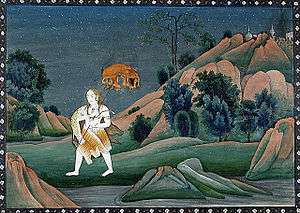Jeshoreshwari Kali Temple
Jeshoreshwari Kali Temple (Bengali: যশোরেশ্বরী কালী মন্দির) is a famous Hindu temple in Bangladesh, dedicated to the goddess Kali. The temple is located in Ishwaripur, a village in Shyamnagar upazilla of Satkhira. The name "Jeshoreshwari" means "Goddess of Jeshore".
Legend
Jeshoreshwari is regarded as one of the 51 Peeth of Sati; according to the belief, it is where the various parts of Sati's body are said to have fallen, in the course of Shiva's Rudra Tandava. Jeshoreshwari represents the site where the palm of Sati fell. Legend says that the General of Maharaja Pratapaditya discovered a luminant ray of light coming from the bushes, and came upon a piece of stone carved in the form of a human palm. Later, Pratapaditya started worshiping Kali, building the Jeshoreshwari Kali Temple. As to be the "Goddess of Jessore", it was named after Jessore.
The Jeshoreshwari Shrine as a Shakti Peeth
Palms of hands and soles of the feet

The mythology of Daksha yaga and Sati's self immolation is the story behind the origin of Shakti Peethas. Shakti Peethas divine places or holy abode of the Mother Goddess(Parashakti). These shrines are believed to be sanctified with the presence of Shakti due to the falling of body parts of the corpse of Sati Devi, when Lord Shiva carried it and wandered throughout Aryavartha in sorrow. There are 51 Shakti Peeth located all around South Asia. Each temple have shrines for Shakti and Kalabhairava, The Shakti of this shrine is addressed as Jeshoreshwari and Bhairava as Chanda.[1][2][3]
History
It is believed to have created by a brahman named Anari. He created a 100-door temple for the Jeshoreshwari Peeth. But the timeline is not to be known. Later it has been renovated by Lakshman Sen and Pratapaditya in their reigning periods.
Worship and rituals
The temple is visited by pilgrims from all over, irrespective of sectarian differences. Worship is done by the priest every Saturday and Tuesday at noon time. But before 1971, there was daily routine of worship. Every year on the day of Kali puja, the present Caretakers of the temple conduct a ceremony. There is also a Mela taking place around the temple compound.
'Natmondir' and architecture
A large rectangular covered platform called Natmondir has been erected adjacent to the main temple, from where the face of goddess can be seen. This was renovated by Laxman Sen in the late 13th century, but the builders are not known. After 1971, it crumbled. Now only the pillars can be seen.
References
- ↑ (Translator), F. Max Muller (June 1, 2004). The Upanishads, Vol I. Kessinger Publishing, LLC. ISBN 1419186418.
- ↑ (Translator), F. Max Muller (July 26, 2004). The Upanishads Part II: The Sacred Books of the East Part Fifteen. Kessinger Publishing, LLC. ISBN 1417930160.
- ↑ "Kottiyoor Devaswam Temple Administration Portal". Sree Kottiyoor Devaswam. Retrieved 20 July 2013.
- Jeshore Khulnar Itihash by Satish Chandra Mitra, pp. 87, 100, 551.
- Baghrotot Parikraman: Satkhira Zillar Itihash O Oitijhyo by Jyoti Chattopadhyay, p. 105.
- Sunderban-er Itihash by AFM Abdul Jalil
Coordinates: 22°18′22″N 89°06′46″E / 22.3062°N 89.1128°E

